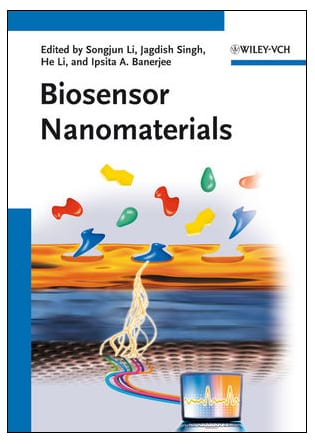 Biosensor Nanomaterials
Biosensor Nanomaterials
Songjun Li (Editor), Jagdish Singh (Editor), He Li (Editor), Ipsita A. Banerjee (Editor)
ISBN: 978-3-527-32841-3
Hardcover
296 pages
US $185.00
Click here for more information
Reviewed by Professor Luisa Torsi, University of Bari
The book “Biosensor Nanomaterials” covers up to date advances in the field of biosensors used for medical and pharmaceutical applications. Particularly it deals with the exploitation of nanomaterials such as carbon nanotubes (CNTs), quantum dots (QDs), dendrimers, magnetic and lipid nanoparticles as building blocks in different types of biosensors and medical diagnostic tools. It is a comprehensive overview consisting of fourteen chapters covering several aspects such as fabrication and evaluation of nanoparticles/nanofibers-based biosensors for the detection of enzymes, viruses, proteins, glucose or DNA.
Moreover, it places a great emphasis in the interfacing of nanomaterials with biological elements. The immobilization of nanomaterials onto sensing platform that can lead to interfaces which enable optical or electrochemical detection of molecular and biomolecular analytes are also presented. Synthesis and applications of carbon nanotubes, conductive and biodegradable polymers and liposomes as supporting substrates for the immobilization of biomolecules are discussed thoroughly, too. The operating principles of different instrumental techniques utilized for structural characterization involving AFM, XPS, X-Ray, SEM, TEM and UV/Visible spectroscopy are given along with the requirements of the sample, if needed, for each technique. Various examples for in vivo and in vitro molecular sensing and imaging using e.g. CNTs and nanoparticles are presented.
Particular attention is paid to nanomaterials used as effective labels to amplify the signal and to design prototype architectures with controlled functions for specific applications. Electrochemical biosensors based on graphene, QDs and chitosan that have been employed successfully are discussed providing all the analytical figures of merit in terms of sensitivity and linear range of detection. A great number of studies are included illustrating the progress achieved on as well as the range of application. Besides, the writers point out main drawbacks that are still a challenge to overcome by scientists. The contents of the book can be a useful for scientists as well as graduated students since it endows the reader with the essential theoretical elements and basic principles. It is recommended for those interested in acquiring more insight knowledge of the latest developments in this still evolving topic.

















